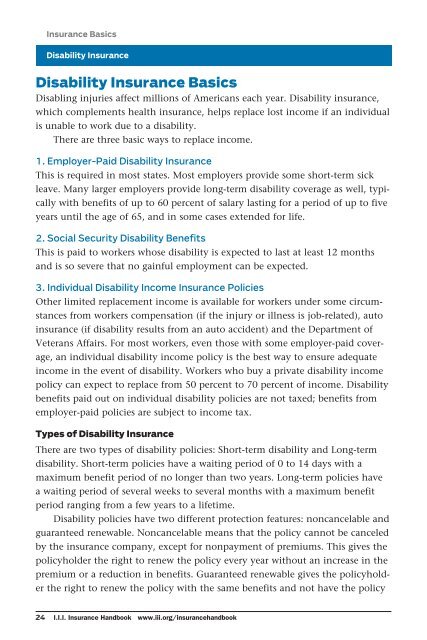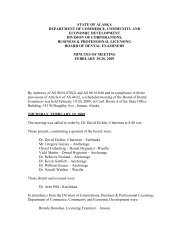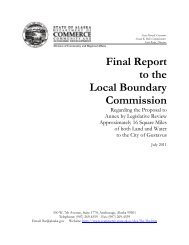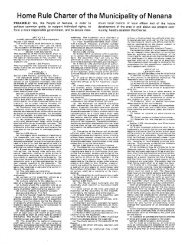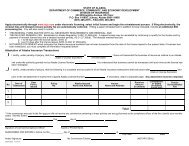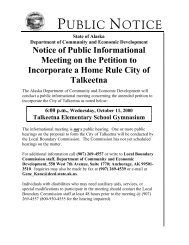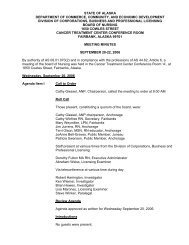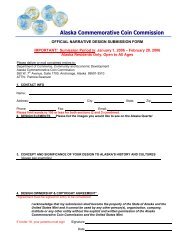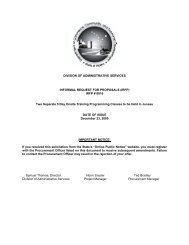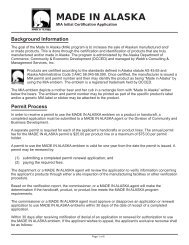Insurance Handbook - Alaska Department of Community and ...
Insurance Handbook - Alaska Department of Community and ...
Insurance Handbook - Alaska Department of Community and ...
You also want an ePaper? Increase the reach of your titles
YUMPU automatically turns print PDFs into web optimized ePapers that Google loves.
<strong>Insurance</strong> Basics<br />
Disability <strong>Insurance</strong><br />
Disability <strong>Insurance</strong> Basics<br />
Disabling injuries affect millions <strong>of</strong> Americans each year. Disability insurance,<br />
which complements health insurance, helps replace lost income if an individual<br />
is unable to work due to a disability.<br />
There are three basic ways to replace income.<br />
1. Employer-Paid Disability <strong>Insurance</strong><br />
This is required in most states. Most employers provide some short-term sick<br />
leave. Many larger employers provide long-term disability coverage as well, typically<br />
with benefits <strong>of</strong> up to 60 percent <strong>of</strong> salary lasting for a period <strong>of</strong> up to five<br />
years until the age <strong>of</strong> 65, <strong>and</strong> in some cases extended for life.<br />
2. Social Security Disability Benefits<br />
This is paid to workers whose disability is expected to last at least 12 months<br />
<strong>and</strong> is so severe that no gainful employment can be expected.<br />
3. Individual Disability Income <strong>Insurance</strong> Policies<br />
Other limited replacement income is available for workers under some circumstances<br />
from workers compensation (if the injury or illness is job-related), auto<br />
insurance (if disability results from an auto accident) <strong>and</strong> the <strong>Department</strong> <strong>of</strong><br />
Veterans Affairs. For most workers, even those with some employer-paid coverage,<br />
an individual disability income policy is the best way to ensure adequate<br />
income in the event <strong>of</strong> disability. Workers who buy a private disability income<br />
policy can expect to replace from 50 percent to 70 percent <strong>of</strong> income. Disability<br />
benefits paid out on individual disability policies are not taxed; benefits from<br />
employer-paid policies are subject to income tax.<br />
Types <strong>of</strong> Disability <strong>Insurance</strong><br />
There are two types <strong>of</strong> disability policies: Short-term disability <strong>and</strong> Long-term<br />
disability. Short-term policies have a waiting period <strong>of</strong> 0 to 14 days with a<br />
maximum benefit period <strong>of</strong> no longer than two years. Long-term policies have<br />
a waiting period <strong>of</strong> several weeks to several months with a maximum benefit<br />
period ranging from a few years to a lifetime.<br />
Disability policies have two different protection features: noncancelable <strong>and</strong><br />
guaranteed renewable. Noncancelable means that the policy cannot be canceled<br />
by the insurance company, except for nonpayment <strong>of</strong> premiums. This gives the<br />
policyholder the right to renew the policy every year without an increase in the<br />
premium or a reduction in benefits. Guaranteed renewable gives the policyholder<br />
the right to renew the policy with the same benefits <strong>and</strong> not have the policy<br />
24 I.I.I. <strong>Insurance</strong> <strong>H<strong>and</strong>book</strong> www.iii.org/insuranceh<strong>and</strong>book


